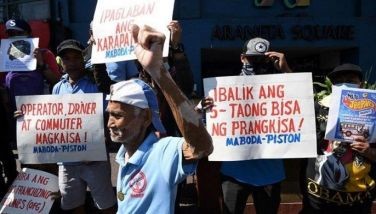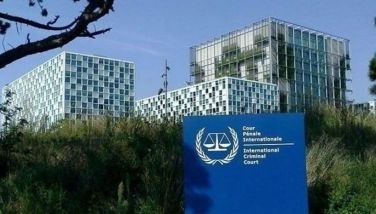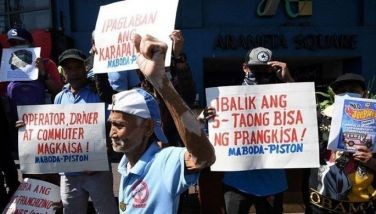Battle for Manila reduces ‘Pearl of the Orient’ to rubble
August 15, 2005 | 12:00am
The Battle for Manila lasted just 28 days. When it ended on March 3, 1945, over 100,000 civilians were dead and the city known as the Pearl of the Orient reduced to rubble.
Six months after street-by-street fighting and US bombardment had leveled the once-proud city, the stench of rotting flesh still lingered in the capital, according to those who survived the ordeal.
"The destruction of Manila was one of the greatest tragedies of World War II. Of all the allied capitals only Warsaw suffered more," wrote American historian William Manchester.
Benito Legarda, who was 18 years old at the time, said the Japanese forces occupying the city since Jan. 2, 1942 went out of their way to make life unlivable once they realized the US military was advancing to recapture the city.
"They dynamited bridges, destroyed utilities and murdered civilians... There was no excuse for what took place in Manila in those 28 days... none at all," Legarda recalls.
Tales of men, women and children being rounded up and shot, mutilated, raped, decapitated or bayonetted by Japanese troops paint the period as one of the darker episodes in the closing chapter of World War II.
By the end of 1944, the tide had turned for Japan and its conquest of Southeast Asia.
On Oct. 20, Gen. Douglas MacArthur, the Allied commander in the Far East, invaded the eastern Philippines in the biggest land and sea assault of the Pacific war with nearly 200,000 men and 700 ships.
MacArthur, who had vowed "I shall return" when he abandoned the Philippines for Australia more than two years earlier, waded ashore — twice, the second time for the benefit of the newsreels — to tell the people of the Philippines in a radio broadcast that he had kept his promise.
At the same time the US navy with her allies took on what was left of the Imperial Japanese Navy in the biggest sea battle in history, the Battle of Leyte Gulf.
For MacArthur it was a race against time to Manila and Luzon where thousands of American soldiers had been interned since the surrender of US and Filipino troops in May 1942.
University of the Philippines historian Ricardo Jose said the Americans surprised the Japanese when they attacked the city from the north on Feb. 3, 1945.
"The Japanese destroyed all six bridges that crossed the Pasig River which divides the city north and south and began torching the Chinese quarter and the old business district of Escolta," he said.
"Basically the city had to be taken building by building, street-by-street. It was hand-to-hand in some quarters, tank and artillery bombardment in others.
"What made the fighting difficult for the Americans was the fact that many of the major buildings were connected by tunnels. So when the Americans thought they had cleared one building and moved on to the next the Japanese would pop up again and attack them from the rear."
After 28 days, on March 3, the last Japanese resistance collapsed. Figures as to the military casualties vary enormously with estimates as high as a total of 22,000 dead.
Jose said some 1,000 Americans died, 4,000 were wounded with more than 8,000 Japanese dead. "Most of the garrison was wiped out in the fighting," he said.
"There was no white flag surrender. The fighting just stopped when the last pocket of resistance had been cleared. Thousands of Japanese civilians that were brought in to run the country were taken prisoner along with Japanese troops who had surrendered.
"As for Manila it was in ruins."
Much of the damage was caused by the US bombardment, Jose Maria Bonifacio Escoda says in his book "Warsaw of Asia: The Rape of Manila."
"Not all buildings were destroyed by the Japanese and not all the massacres were perpetrated by them. Much destruction and many deaths were caused by American bombings from the air and shelling by artillery."
He says Filipinos were often mistaken for Japanese and were shot by American troops or strafed and bombed by their pilots. — AFP
Six months after street-by-street fighting and US bombardment had leveled the once-proud city, the stench of rotting flesh still lingered in the capital, according to those who survived the ordeal.
"The destruction of Manila was one of the greatest tragedies of World War II. Of all the allied capitals only Warsaw suffered more," wrote American historian William Manchester.
Benito Legarda, who was 18 years old at the time, said the Japanese forces occupying the city since Jan. 2, 1942 went out of their way to make life unlivable once they realized the US military was advancing to recapture the city.
"They dynamited bridges, destroyed utilities and murdered civilians... There was no excuse for what took place in Manila in those 28 days... none at all," Legarda recalls.
Tales of men, women and children being rounded up and shot, mutilated, raped, decapitated or bayonetted by Japanese troops paint the period as one of the darker episodes in the closing chapter of World War II.
By the end of 1944, the tide had turned for Japan and its conquest of Southeast Asia.
On Oct. 20, Gen. Douglas MacArthur, the Allied commander in the Far East, invaded the eastern Philippines in the biggest land and sea assault of the Pacific war with nearly 200,000 men and 700 ships.
MacArthur, who had vowed "I shall return" when he abandoned the Philippines for Australia more than two years earlier, waded ashore — twice, the second time for the benefit of the newsreels — to tell the people of the Philippines in a radio broadcast that he had kept his promise.
At the same time the US navy with her allies took on what was left of the Imperial Japanese Navy in the biggest sea battle in history, the Battle of Leyte Gulf.
For MacArthur it was a race against time to Manila and Luzon where thousands of American soldiers had been interned since the surrender of US and Filipino troops in May 1942.
University of the Philippines historian Ricardo Jose said the Americans surprised the Japanese when they attacked the city from the north on Feb. 3, 1945.
"The Japanese destroyed all six bridges that crossed the Pasig River which divides the city north and south and began torching the Chinese quarter and the old business district of Escolta," he said.
"Basically the city had to be taken building by building, street-by-street. It was hand-to-hand in some quarters, tank and artillery bombardment in others.
"What made the fighting difficult for the Americans was the fact that many of the major buildings were connected by tunnels. So when the Americans thought they had cleared one building and moved on to the next the Japanese would pop up again and attack them from the rear."
After 28 days, on March 3, the last Japanese resistance collapsed. Figures as to the military casualties vary enormously with estimates as high as a total of 22,000 dead.
Jose said some 1,000 Americans died, 4,000 were wounded with more than 8,000 Japanese dead. "Most of the garrison was wiped out in the fighting," he said.
"There was no white flag surrender. The fighting just stopped when the last pocket of resistance had been cleared. Thousands of Japanese civilians that were brought in to run the country were taken prisoner along with Japanese troops who had surrendered.
"As for Manila it was in ruins."
Much of the damage was caused by the US bombardment, Jose Maria Bonifacio Escoda says in his book "Warsaw of Asia: The Rape of Manila."
"Not all buildings were destroyed by the Japanese and not all the massacres were perpetrated by them. Much destruction and many deaths were caused by American bombings from the air and shelling by artillery."
He says Filipinos were often mistaken for Japanese and were shot by American troops or strafed and bombed by their pilots. — AFP
BrandSpace Articles
<
>
- Latest
- Trending
Trending
Latest
Trending
Latest
Recommended






























